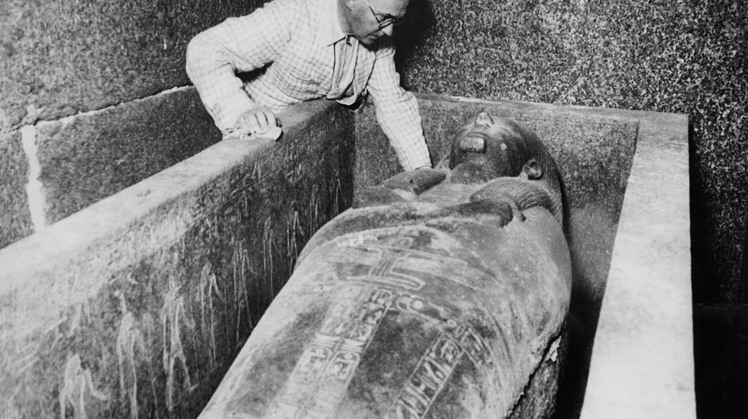The tomb of Pharaoh Psusennes 1 ruler of the 21st dynasty, he who reigned from 1036 to 989 BCE, is surely one of the most underrated discoveries in the scheme of things at Egypt.
The Kings and Pharaohs of Ancient Egypt surrounded themselves with treasures, mostly fashioned from gold.
This was not so much out of motives of greed but because they believed that the proximity of gold would ensure that Pharoah would receive the gift of eternal life.
It is life in quest of life in bodies that fear the grave
There are no graves here
These mountains and plains are a cradle and a stepping-stone
Like the sun, which reappeared each morning after having sunk into the underworld the evening before, gold gave man the power to return to life.
Psusennes I was a chief priest of the Sun God Amun at Tanis and traced his family lineage back to the great Pharoah Ramesses I. Psusennes name means“The Star Appearing in the City”. His highly refined very sophisticated gold death mask was to be his face in the world to come.
My heart is the heart of the sun the heart of the sun is my heart’.
Gold became the perfect motive for tomb robbers to desecrate the sacred graves of their Pharaoh’s. One inscription found tells us ‘The noble mummy of the king was entirely laid over with gold….and…we found the queen likewise; we collected together all that we found on her also…and… divided it into eight shares.
Many outstanding works of the goldsmith’s art crafted during the Pharaonic period in Egypt are now in museums around the world. These surviving jewels bear witness, not only to a very refined and lavish art, but also the preoccupation and belief in the importance of entering the realm of the afterlife in style.
For the ancient Egyptian gold was prized for its intrinsic worth and redolent of many virtues – mythical, religious and symbolic. It resisted rust and decay and beautiful golden objects unearthed around the world for centuries have remained virtually unscathed by the passage of time.
The ancient Egyptian desired gold as a symbol of survival and eternity and their myths describe the gods as possessing ‘silver bones, golden flesh and lapis lazuli beards’.
Silver in ancient Eygpt was symbolic of the Moon. However silver was far less common and so that’s why finding that the royal burial chamber of Psusennes 1 contained a silver sarcophagus was so startling, although the timing for finding it couldn’t have been worse.
The tomb of Psusennes 1 and his wife Mutnedjmet was found by French Egyptologist Pierre Montet 1885 – 1996, who conducted major excavations of the relics of the New Kingdom (1567- 525 B.C.E.) at the ancient capital of Tanis in the Nile Delta.
Tanis was the site of numerous archaeological digs beginning in the 19th century, involving renowned Egyptologists Flinders Petrie and Auguste Mariette. Montet found that he was trapped in a race against the clock with the imminent outbreak of World War II.
So what should have been a well planned and carefully considered archaeological excavation turned into a hurried salvage operation. And yes, Montet is the archaeologist that inspired the character of Dr René Belloq in the movie Indiana Jones.
Pharaoh Psusennes I up until that point in the discovery had been just an obscure ruler, who had governed Egypt more than 3000 years before during one of its most difficult periods. Egypt during his reign was a fractured kingdom divided between the rival rulers of north and south.
The high priests seized power seeking to command the southern region from Thebes, while the deposed pharaohs were exiled north to Tanis. From Tanis, Psusennes ruled for an impressive 46 years; a later study of Psusennes’ skeleton revealed a hard-working man who suffered from a debilitating rheumatic disease, but nevertheless lived well into his eighties.
Any study of the gold work of the Pharaohs must explore beyond its use in the jewellery of the living and the brilliant frivolities of ornamental art to investigate its fundamental cultural role. It was the object of a cult which stemmed from its religious significance. Its use by the dead was a privilege reserved for the high born, serving also as an emblem of their power.
Pharaoh was, for all intents and purposes, ‘golden Horus’ incarnate, son of the God Osiris who ruled the Underworld. Ancient Egyptians had access to precious metals throughout, what modern archaeologists have recorded as the dynastic period, the dating of which began c 3100 BCE with the 1st Dynasty until the 26th dynasty of 664 – 525 BCE. All amulets, talismans, jewellery and ornaments intended to protect the deceased during his perilous journey through Hades were mainly made from gold.
Pharaohs and artisans, princesses and peasants alike all adorned themselves both in life and in death, and the jewellery and objects that have survived testify to the prosperity, style preferences and innate craftsmanship of Egyptian kings and their people. Jewellery permeated every facet of Egyptian civilization and was revered at every level of society.
The ancient Egyptians established a civilisation that was envied and admired for 3000 years. In life jewellery was not just a colourful accessory to their simple costume; it denoted rank or honour, and also offered protection.
After death it was buried with its owner together with special pieces of jewellery made especially for the funeral.
Talismans were just as important in the afterlife as in the present, if not more so. The perils to be met in the next world, as enumerated in the many religious texts that survive. The Book of what is in the Underworld, were far more threatening than anything found in this world. This meant the deceased would therefore need all the protective devices available to assist him.
 Tue, Oct. 19, 2021
Tue, Oct. 19, 2021